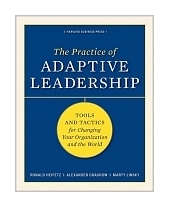|
||
• wydawnictwa polskie
• Zamów informacje o nowościach z wybranego tematu • kontakt
• Cookies na stronie |
PRACTICE OF ADAPTIVE LEADERSHIPHEIFETZ R. LINSKY M. GRASHOW A.wydawnictwo: HBS , rok wydania 2009, wydanie Icena netto: Practice of Adaptive Leadership: Tools and Tactics for Changing Your Organization and the WorldWhen change requires you to challenge people's familiar reality, it can be difficult, dangerous work. Whatever the context—whether in the private or the public sector—many will feel threatened as you push though major changes. But as a leader, you need to find a way to make it work. Ron Heifetz first defined this problem with his distinctive theory of adaptive leadership in Leadership Without Easy Answers. In a second book, Leadership on the Line, Heifetz and coauthor Marty Linsky highlighted the individual and organizational dangers of leading through deep change in business, politics, and community life. Now, Heifetz, Linsky, and coauthor Alexander Grashow are taking the next step: The Practice of Adaptive Leadership is a hands-on, practical guide containing stories, tools, diagrams, cases, and worksheets to help you develop your skills as an adaptive leader, able to take people outside their comfort zones and assess and address the toughest challenges. The authors have decades of experience helping people and organizations create cultures of adaptive leadership. In today's rapidly changing world, The Practice of Adaptive Leadership can be your handbook to meeting the demands of leadership in the midst of complexity. Table of Contents Preface xi Acknowledgments xv Part 1 Introduction: Purpose and Possibility 1 How to Use This Book 5 Overview 8 Adaptive Challenges and Adaptive Capacity 10 2 The Theory Behind the Practice 13 The Illusion of the Broken System 17 Distinguishing Technical Problems from Adaptive Challenges 19 Distinguishing Leadership from Authority 23 Living in the Disequilibrium 28 Observe, Interpret, Intervene 32 Experiment and Take Smart Risks Smartly 36 Engage Above and Below the Neck 37 Connect to Purpose 38 3 Before You Begin 41 Don't Do It Alone 41 Live Life as a Leadership Laboratory 42 Resist the Leap to Action 44 Discover the Joy of Making Hard Choices 45 Part 2 Diagnose the System 4 Diagnose the System 49 The Elegance and Tenacity of the Status Quo 49 Discover Structural Implications 54 Surface Cultural Norms and Forces 57 Recognize Default Interpretations and Behavior 63 5 Diagnose the Adaptive Challenge 69 Determine the Technical and Adaptive Elements 70 Listen to the Song Beneath the Words 76 Four Adaptive Challenge Archetypes 77 6 Diagnose the Political Landscape 89 Uncover Values Driving Behavior 91 Acknowledge Loyalties 93 Name the Losses at Risk 96 Realize Hidden Alliances 97 7 Qualities of an Adaptive Organization 101 Name the Elephants in the Room 102 Share Responsibility for the Organization's Future 103 Value Independent Judgment 103 Build Leadership Capacity 104 Institutionalize Reflection and Continuous Learning 105 Part 3 Mobilize the System 8 Make Interpretations 113 Notice When People Are Moving Toward the Left Side of the Chart 116 Reframe the Group's Default Interpretations 118 GenerateMultiple Interpretations 120 Audition Your Ideas 122 Generate a Diversity of Interpretations 122 9 Design Effective Interventions 125 Step 1 Get on the Balcony 126 Step 2 Determine the Ripeness of the Issue in the System 126 Step 3 Ask, Who Am I in This Picture? 128 Step 4 Think Hard About Your Framing 128 Step 5 Hold Steady 129 Step 6 Analyze the Factions That Begin to Emerge 130 Step 7 Keep the Work at the Center of People's Attention 130 10 Act Politically 133 Expand Your Informal Authority 133 Find Allies 136 Stay Connected to the Opposition 138 Manage Authority Figures 142 Take Responsibility for Casualties 144 Protect and Engage the Voices of Dissent 145 11 Orchestrate Conflict 149 Create a Holding Environment 155 Select Participants 158 Regulate the Heat 159 Give the Work Back 161 12 Build an Adaptive Culture 165 Make Naming Elephants the Norm 166 Nurture Shared Responsibility for the Organization 168 Encourage Independent Judgment 169 Develop Leadership Capacity 170 Institutionalize Reflection and Continuous Learning 171 Part 4 See Yourself as a System 13 See Yourself as a System 181 Your Many Identities 182 14 Identify Your Loyalties 187 Prioritize Your Loyalties 189 Name Your Unspeakable Loyalties 191 15 Know Your Tuning 195 Know Your Triggers 200 Hungers and Carrying Water 201 16 Broaden Your Bandwidth 205 Discover Your Tolerances 206 17 Understand Your Roles 209 What Roles Do You Play? 210 Identify Your Scope of Authority 215 18 Articulate Your Purposes 221 Prioritize Your Purposes 225 The Story You Tell Yourself 228 Part 5 Deploy Yourself 19 Stay Connected to Your Purposes 233 Negotiate the Ethics of Leadership and Purpose 233 Keep Purposes Alive 236 Negotiate Your Purposes 239 Integrate Your Ambitions and Aspirations 242 Avoid Common Traps 244 20 Engage Courageously 247 Get Past the Past 247 Lean Into Your Incompetence 252 Fall in Love with Tough Decisions 255 Get Permission to Fail 258 Build the Stomach for the Journey 260 21 Inspire People 263 Be with Your Audience 264 Speak from the Heart 269 22 Run Experiments 277 Take More Risks 280 Exceed Your Authority 282 Turn Up the Heat 284 Name Your Piece of the Mess 286 Display Your Own Incompetence 287 23 Thrive 289 Grow Your Personal Support Network 289 Create a Personal Holding Environment 292 Renew Yourself 295 Notes 299 Glossary 303 Index 309 About the Authors 325 352 pages, Hardcover Księgarnia nie działa. Nie odpowiadamy na pytania i nie realizujemy zamówien. Do odwolania !. |


